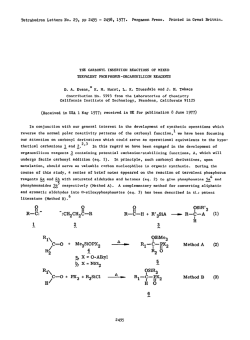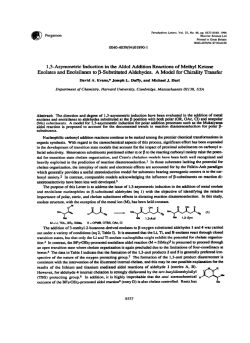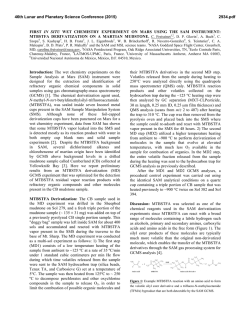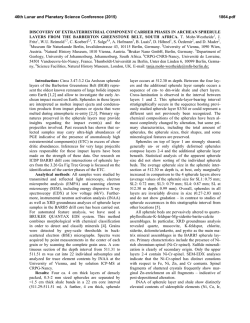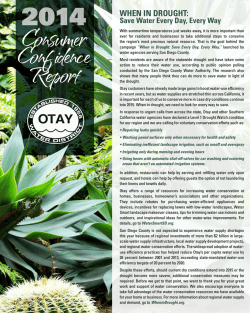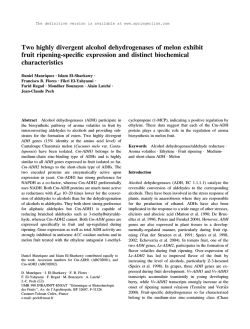
Headspace Solid Phase Microextraction/Gas Chromatography for
Headspace Solid Phase Microextraction/Gas Chromatography for Determination of Aldehydes Winyu Chitsamphandhvej1*, Panthira Ketkeaw1, Praphatpong Nonsung1 and Pichan Chiamchunkoop1 ABSTRACT A headspace solid-phase microextraction (HS-SPME) procedure was developed for the determination of aldehydes. The aldehydes were derivatized to form oxime with O-2,2,4,5,6(pentafluoro-benzyl) hydroxylamine (PFBHA), prior to the extraction using HS-SPME and analyzed by gas chromatograph-flame ionization detector. The optimum condition for HS-SPME was studied. It was found that the acceptable results were obtained when 0.50 g of NaCl was added into 4.00 mL of aqueous sample, followed by 0.50 mL of 1000.0 ppm PFBHA solution, stirred for 5 minutes, and then extracted at room temperature for 10 minutes with a PDMS/DVB coated fiber. The fiber was then desorbed at 2500C for 5 minutes and analyzed by GC-FID. The external standard calibration curves showed good linearity (R2 > 0.995) over the range of 0.5-1000 ppb for formaldehyde; 1.0-700 ppb for acetaldehyde, propanal, butanal and hexanal; and 1.0-500 ppb for heptanal. Detection limits and quantification limits varied from 0.0005 to 1.0 ppb and 0.5-1.0 ppb, respectively. This method was applied to the analysis of aldehydes in the seafood immersed water samples. Formaldehyde and acetaldehyde were found in these samples in the concentration range of 13-31 ppb and 33-179 ppb, respectively. The relative standard deviations (RSD) and the recoveries of the analyses ranged from 0.6 %-3.3 % and 96.5%-105.3% were obtained, showing that the precision and accuracy of this method are good. Key words: low molecular weight aldehyde, solid phase microextraction . *Corresponding author; e-mail address: [email protected] Department of Chemistry, Faculty of Science,King Mongkut’s University of Technology Thonburi, Bangkok, Thailand, 10140. INTRODUCTION In recent years, aldehydes are receiving increasing attention as disinfection and oxidation byproducts formed during drinking water treatment processes, especially those with low molecular weights. Formaldehyde is classified as a human carcinogen that causes nasopharyngeal cancer and probably leukemia. and acetaldehyde induces tumors; propanal, butanal, pentanal, hexanal, nonanal, glyoxal, methyl glyoxal are mutagens in laboratory animals. Besides the health affects mentioned above, these aldehydes may also cause taste and odor problems in drinking water (Shih and Chun, 2003). Analysis of aldehydes in water is very difficult due to low concentrations and high polarity, derivatizations prior to their detection by a chromatographic or spectroscopic technique are widely performed for the low-molecular-weight aldehydes. For example, derivatization with 2,4dinitrophenylhydrazine (2,4-DNPH) followed by liquid–liquid extraction (LLE) has been used by the US Environmental Protection Agency (US EPA). The 2,4-DNPH method potentially allows specific quantitation of different aldehydes and ketones through high performance liquid chromatography (HPLC)/ ultraviolet (UV) detection of their hydrazones but not by gas chromatography (GC) since many hydrazones decompose at high temperatures (Tsai and Chang, 2002). Another commonly used method for determining aldehydes is based on derivatization with O-2,3,4,5,6-(pentafluorobenzyl)hydroxylamine hydrochloride (PFBHA). PFBHA reacts with carbonyls to form the corresponding oximes. PFBHA method has also been suggested by both the US EPA and the US American Public Health Association (APHA). All the methods mentioned above involve complex procedures for sample preparations and therefore very time-consuming (Cancilla and Que Hee,1992). The technique called solid-phase microextraction (SPME) has been developed by Pawliszyn, (1999). SPME presents many advantages over conventional methods by combining sampling, preconcentration, and direct transfer of the analytes into a GC. Sampling and analysis method for aldehydes in air which combined PFBHA with SPME technique have been reported. For water sample, aldehydes derivatized with PFBHA to form oximes in solutions followed by extraction with SPME from liquid or headspace and analyzed by GC/ECD was also reported (Svensson et. Al, 2007). The research shown here reported another approach to determine the low molecular weight aldehydes; formaldehyde (C1), acetaldehyde (C2), propanal (C3), butanal (C4), hexanal (C6) and heptanal (C7) by derivatization with PFBHA followed by extraction of headspace aldehydes-PFBHA oximes using SPME fiber and analysis by GC/FID. MATERIALS AND METHODS Chemical and reagents o-2, 3, 4, 5 ,6 (pentafluoro- benzyl) hydroxylamine hydrochloride, PFBHA was purchased from Sigma-Aldrich, and the 1000.0 ppm aqueous solution of PFBHA was prepared daily. Form maldehyde (37 % in water) w and sodium chloride were purchasedd from Ajaxx Finechem. Acetaldehyde (99.5 %) waas purchaseed from Riedel-de Haenn. Propanal,, butanal, hexanal h and hepttanal were purchased from Fluka.. Deionized water was purchased from the Governmentt Pharmaceutical Organizationn. Stock of sstandard aldeehydes 10000.0 ppm were re prepared in deionized wateer and storee at 4OC. Working standdard solutionns at different concentraation were prepared p byy appropriate diluttion. Instrrumentation The GC/FID study was w performeed with Variaan model CPP-3800 gas chromatograaph. Manual SPM ME Holder annd PDMS/DVBB fiber (65 μm) were purcchased from Supelco. GC//FID instrumeental conditioon w set as foollows: temperature of injjection port and a FID weree equally set at 250OC. A The conditions were 30 m x 0.25 mm m. id. CP SILL 8 CB with 0.25 μm film m thickness was w used for separation of o aldehydePFBBHA oximes. The carrier gas was heelium with floow rate of 1.0 mL/min. TThe initial tem mperature off O O O O O 50 C were rampped at 4 C/m min to 220 C and 20 C/min to 250 C and thhe analysis time t was 45 minuutes. Helium m was used as makeup gas with floow rate of 255 mL/min annd H2/Air floww at 30/300 mL/m min. Stanndard and saample preparrations The standard solutions or seafood immerrged water saamples weree prepared bby transferringg 4.00 mL off solution, 0.50 mL m of 1000 ppm PFBHA ssolution and 0.50 g of NaaCl into a 10 mL headspace vial and imm mediately cappped. The solution was sttirred with magnetic stirreer for 5 minuttes. The derivatization off aldeehydes with PFBHA was performed tto produce vaporized v oxximes in heaadspace area. Figure 1 showws a reactioon scheme for the derrivatization of o aldehydess with PFBHHA reagent to give two geometric isomeers oxime prooducts.[6] Figuure 1 Reactioon scheme foor the derivaatization of ann aldehyde with w PFBHA too give cis- annd transoxime isomers. i HS-SSPME proceedure Before itts first use thhe fiber was pprepared by desorbing possible p conttaminants in the injection portt of the GC for 30 min at a 250 OC. TThe fiber wass then expoosed to a hheadspace of o standard mple which were w preparedd according to the above procedure solution or seafoood immersed water sam for 10 minutes. The fiber was w then traansferred im mmediately too the injectioon port of the t GC and O desoorbed for 5 minutes m at 2550 C. Optiimum conditions studies Standardd solutions which w were prepared acccording to the above pprocedure were w used to studdy the effect of heating tim me (5-30 minnutes), tempeerature of solution ( room m temperaturee, 50 OC and 70 OC), amountt of NaCl (0.50g, 1.00 g and 1.50 g), desorption time (3- 10 minutes) in order to deteermine the opptimum condditions for HSS/SPME sampple preparation. Deteermination off aldehydes in real sampples. These days, d formalddehyde is used in order to prevent from spoilinng, and to increase the storaage time. Beefore putting on shelf, seeafood is firsstly dipped in formaldehyyde–water solution for a periood of time by dishonest mongers. Thhe seafood dipped d with formaldehyd f de is a big danger to the physsical health of o consumerr. In this studdy, two of seeafood immeersed water ssamples werre analyzed, the cconcentration of aldehyddes in samplees, the precision in the teerm of % relaative standarrd deviations and the accuraccy in the term m of % recoveeries were reeported. Thesse days, form maldehyde iss used in ordder RESUULTS AND DISCUSSIO D ON Figure 2 showed typical t GC/FFID chromatogram of standard s soolution of aldehydes att conccentration eqqualed 0.50 ppm. PFBBHA was addded and oxximes of alddehydes were formed in solutions and vaaporized to headspace h bby magnetic stirring. Thee headspacee oximes were extracted with SPME fiber,, desorbed inn injection poort of GC and separated in GC colummn. It was obbserved thatt theree were cis and trans-isomers of the oximes beecause aldeehydes weree asymmetriccal carbonyl com mpounds, exccept formaldeehyde. Figure 2 GC Chromaatogram of aaldehyde-PFBBHA oximes. (0.50 ppm oof standard solution) s The influuence of some parametters for HS-SSPME sampling step weere investigated and the resuults were shoown in Figuree 3-5. From tthe study, seelected paraameters for ooptimum conditions were as ffollows: NaCCl 0.50 grams; extractionn time, 10 minutes m at room temperaature; desorpption time, 5 minuutes. Figure 3 Efffect of amount of NaCl onn peak areass of aldehydee-PFBHA oxim mes Figuure 4 Effect on o extractionn time and teemperature on peak areass of aldehydee-PFBHA oximes. (A) room temperatuure (28± 2 oCC), (B) 50 oC and a (C) 70 oC Figure 5 Effect of am mount of dessorption time on peak areeas of aldehyyde-PFBHA oximes o Usinng the optimum condittions, determination of aldehyde llevels in saamples was perfformed with external staandardizationn method. Good G linearitty and correelation coefficients were obtaained. Detecction limits and a quantificcation limits varied v from 0.0005 to 1. 0 ppb and 0.5-1.0 0 ppb, resppectively. In this t study, twwo of seafoood immersed water sampples were anaalyzed. Recooveries were deteermined by spiking the sample withh appropriate quantitiess of standarrd solutions. All relative stanndard deviations (%RSDDs) observedd are equal to or less than 3.3%. TThe results of analytical charracters for thhis study andd the result off analysis weere shown in Table 1. Table 1 Some analytical a chaaracters of HS-SPME/GC /FID obtaineed from this sstudy and thee quantificcation resultss Analytical charaacter Linear range Linear Equuation Linearity L (R2) LOD LOQ (ppb) (ppb) ( (ppb) Forrmaldehyde (C1) 0.5-1000.0 Y = 878.22 x +13822 0.9966 <0.0005 0.5 Acetaldehyde (C ( 2) 1.00-700.0 Y = 106.08 X + 689 0.9954 <0.0005 1.0 Proopanal (C3) 0.9984 1.00-700.0 Y = 433.45 X + 2044 0.05 1.0 0.9952 Butanal (C4) 1.00-700.0 Y = 298.51 X + 2657 <0.0005 1.0 0.9978 Heexanal (C6) 1.00-700.0 Y = 74.071 X + 872 0.05 1.0 0.9974 Heeptanal (C7) 1.00-500.0 Y = 33.038 X + 442 1.0 1.0 Concentration C n (ppb) Waater sample C1 C2 C3 C4 C6 C7 Sample I 311.01 179.2 - - - Sample II 133.31 32.57 - - - 1.1 1 2.7 3.3 1.3 % RSD (n=6) 0.6 3.3 101.6 101.1 104.7 %RRecovery (n==3) 96.5 9 105.3 102.6 CONCLUSION An analytical methodology for the determination of low molecular-weight aldehydes (C1-C7) in aqueous solution has been described. The work presented here in has demonstrated that headspace solid phase microextraction/ gas chromatographic analysis of PFBHA derivatives. Because of the good recoveries, relative standard deviation and sensitivity, the HS-SPME /GC/FID is considered to be an efficient technique for determination of low molecular weight aldehydes in aqueous solution. In addition, this technique is simple, solvent free and timesaving. REFERENCES Cancilla, D.A. and S. S. Que Hee. 1992. O-(2,3,4,5,6-pentafluorophenyl)methylhydroxylamine hydrochloride: a versatile reagent for the determination of carbonyl-containing compounds. J. Chromatogr 627(1-2): 1-16. Pawliszyn J. 1999. Applications of Solid Phase Microextraction, Royal Society of Chemistry, Cambridge. Shih, W. T. and M.C. Chun. 2003. Analysis of aldehydes in water by solid-phase microextraction with on-fiber derivatization. J. Chromatography A 1015:143–150. Svensson, S. M. L¨arstad. K. Broo and A. Olin. 2007. Determination of aldehydes in human breath by on-fibre derivatization, solid phase microextraction and GC–MS. J. Chromatogr. B 860: 86– 91. Tsai, S.W. and T.A. Chang. 2002. Time-weighted average sampling of airborne n-valeraldehyde by a solid-phase microextration device. J. Chromatogr. A 954:191-198.
© Copyright 2026
